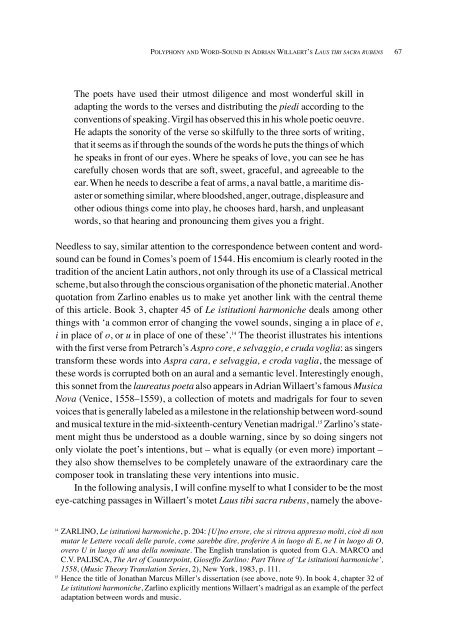YEARBOOK OF THE ALAMIRE FOUNDATION
YEARBOOK OF THE ALAMIRE FOUNDATION
YEARBOOK OF THE ALAMIRE FOUNDATION
You also want an ePaper? Increase the reach of your titles
YUMPU automatically turns print PDFs into web optimized ePapers that Google loves.
POLYPHONY AND WORD-SOUND IN ADRIAN WILLAERT’S LAUS TIBI SACRA RUBENS<br />
The poets have used their utmost diligence and most wonderful skill in<br />
adapting the words to the verses and distributing the piedi according to the<br />
conventions of speaking. Virgil has observed this in his whole poetic oeuvre.<br />
He adapts the sonority of the verse so skilfully to the three sorts of writing,<br />
that it seems as if through the sounds of the words he puts the things of which<br />
he speaks in front of our eyes. Where he speaks of love, you can see he has<br />
carefully chosen words that are soft, sweet, graceful, and agreeable to the<br />
ear. When he needs to describe a feat of arms, a naval battle, a maritime disaster<br />
or something similar, where bloodshed, anger, outrage, displeasure and<br />
other odious things come into play, he chooses hard, harsh, and unpleasant<br />
words, so that hearing and pronouncing them gives you a fright.<br />
Needless to say, similar attention to the correspondence between content and wordsound<br />
can be found in Comes’s poem of 1544. His encomium is clearly rooted in the<br />
tradition of the ancient Latin authors, not only through its use of a Classical metrical<br />
scheme, but also through the conscious organisation of the phonetic material. Another<br />
quotation from Zarlino enables us to make yet another link with the central theme<br />
of this article. Book 3, chapter 45 of Le istitutioni harmoniche deals among other<br />
things with ‘a common error of changing the vowel sounds, singing a in place of e,<br />
i in place of o, or u in place of one of these’. 14 The theorist illustrates his intentions<br />
with the first verse from Petrarch’s Aspro core, e selvaggio, e cruda voglia: as singers<br />
transform these words into Aspra cara, e selvaggia, e croda vaglia, the message of<br />
these words is corrupted both on an aural and a semantic level. Interestingly enough,<br />
this sonnet from the laureatus poeta also appears in Adrian Willaert’s famous Musica<br />
Nova (Venice, 1558–1559), a collection of motets and madrigals for four to seven<br />
voices that is generally labeled as a milestone in the relationship between word-sound<br />
and musical texture in the mid-sixteenth-century Venetian madrigal. 15 Zarlino’s statement<br />
might thus be understood as a double warning, since by so doing singers not<br />
only violate the poet’s intentions, but – what is equally (or even more) important –<br />
they also show themselves to be completely unaware of the extraordinary care the<br />
composer took in translating these very intentions into music.<br />
In the following analysis, I will confine myself to what I consider to be the most<br />
eye-catching passages in Willaert’s motet Laus tibi sacra rubens, namely the above-<br />
14 ZARLINO, Le istitutioni harmoniche, p. 204: [U]no errore, che si ritrova appresso molti, cioè di non<br />
mutar le Lettere vocali delle parole, come sarebbe dire, proferire A in luogo di E, ne I in luogo di O,<br />
overo U in luogo di una della nominate. The English translation is quoted from G.A. MARCO and<br />
C.V. PALISCA, The Art of Counterpoint, Gioseffo Zarlino: Part Three of ‘Le istitutioni harmoniche’,<br />
1558, (Music Theory Translation Series, 2), New York, 1983, p. 111.<br />
15 Hence the title of Jonathan Marcus Miller’s dissertation (see above, note 9). In book 4, chapter 32 of<br />
Le istitutioni harmoniche, Zarlino explicitly mentions Willaert’s madrigal as an example of the perfect<br />
adaptation between words and music.<br />
67











